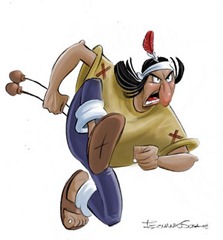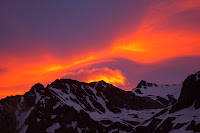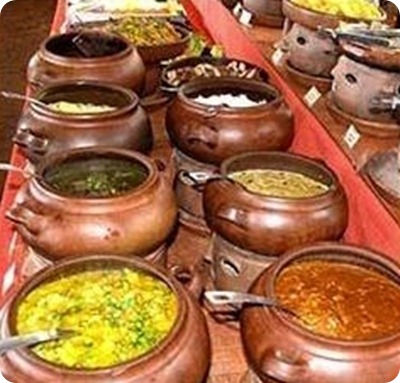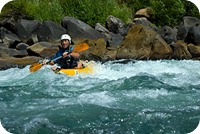The 10 Most Popular Posts on Argentina Photo Gallery in March 2013.
1.- The Andes mountain range shows its beauty in the Patagonian provinces.

The Andes mountain range shows its beauty in the Patagonian provinces. Millennial silent forests with native vegetable species are extended along the shores of glistening waters.
On top of the mountains, nature overflows with granite peaks and ice fields spreading their glacier tongues into lakes of unsurpassable beauty.
Imposing mammals and sea birds, half-way between real life and fantasy, spend certain seasons on the rough coasts of Patagonia where they complete part of their life cycle. Seals colonies play on the islets and sandbanks.
The world’s most important southern elephant seal continental colony is located in Peninsula Valdés.
Every year, southern right whales come to Nuevo and San José gulfs to breed.
2.-The nine sites of memory.
 From now until Tuesday, the Human Rights Secretariat ran signaled spaces where detention and torture during the dictatorship, in Buenos Aires, Córdoba, Santa Fe, San Juan, and Mendoza Misiones.
From now until Tuesday, the Human Rights Secretariat ran signaled spaces where detention and torture during the dictatorship, in Buenos Aires, Córdoba, Santa Fe, San Juan, and Mendoza Misiones.
The Federal Network of Sites of Memory signaled from today until next Tuesday nine former clandestine detention centers in the provinces of Buenos Aires, Córdoba, Santa Fe, Mission, San Juan and Mendoza. Coordinated by the National Archive of Memory (ANM) and under the aegis of the Ministry of Human Rights of the Nation, the network reported that the signs "include information on the operation of each site under the repressive system and expressed in the public space of the democratic state committed to publicize and condemn these heinous acts, so they never happen again. "
3.- Cartoon (Comic) in Argentina: Patoruzú, one of the great milestones rioplatense humor.
 Patoruzú, created by Dante Quinterno in 1928, is one of the most important and influential cartoon Argentina.
Patoruzú, created by Dante Quinterno in 1928, is one of the most important and influential cartoon Argentina.
Born as a secondary character in two short-lived comic strip, the chief Patoruzú-the last of the tehuelches, which the Spanish conquerors had seen at the time as giants endowed with prodigious strength-soon got his own comic, which would origin to the early sixties, one of the great landmarks of humor in Argentina.
Quinterno drew original stories intermittently for nearly forty years, and reprints were numerous. From the 40s and 50s of the twentieth century became one of the icons of popular culture Argentina.
The identity of Patoruzú underwent several alterations in the early years.
4.- Nahuel Huapi National Park is the oldest Argentine national park, in Patagonia in the foothills of the Andes mountains.
 Nahuel Huapi National Park is the oldest Argentine national park, in Patagonia in the foothills of the Andes mountains. It was established in 1934, but the nucleus of the park is the land donated to the federal government by Perito Moreno in 1903.
Nahuel Huapi National Park is the oldest Argentine national park, in Patagonia in the foothills of the Andes mountains. It was established in 1934, but the nucleus of the park is the land donated to the federal government by Perito Moreno in 1903.
The park covers approximately 7050 km² and is located in the southwest of the Neuquén and northwest of the Río Negro provinces bordering with Chile. The largest city within the park and a base for tourism is the city of San Carlos de Bariloche. Villa La Angostura is another lakeside resort also within the boundaries of the park.
5.- The Giant Armadillo (Priodontes maximus), colloquially Tatou, Ocarro, Tatu-canastra or Tatú Carreta, is the largest living species of armadillo.
 The Giant Armadillo (Priodontes maximus), colloquially Tatou, Ocarro, Tatu-canastra or Tatú Carreta, is the largest living species of armadillo.
The Giant Armadillo (Priodontes maximus), colloquially Tatou, Ocarro, Tatu-canastra or Tatú Carreta, is the largest living species of armadillo.
It was once found widely throughout the tropical forests of eastern South America and now ranges throughout varied habitat as far south as northern Argentina.
This species is considered vulnerable to extinction.
These armadillos typically weigh around 28 kilograms (62 lb) when fully grown, but a 32 kilograms (71 lb) specimen has been weighed in the wild. A typical length is 89 cm (35 in), of which a third to two-fifths is likely to be accounted for by the tail.
6.- Cerro Aconcagua is the highest peak of the Americas and the highest peak in the world outside of Asia.

Cerro Aconcagua, often referred to as the "Stone Sentinel" ("Centinela de Piedra"), with its 6,962 meters (22,841 feet) is the highest peak of the Americas and the highest peak in the world outside of Asia. This giant towers all the neighboring five thousand meters peaks.
Some of the various challenges to climb the summit are : fog, altitude, cold and winds, especially the "Viento Blanco"; those very cold winds can blow at 180 kph (110 mph) and the temperature can drop down to -45°C (-50°F). The normal route is a non-technical climb, the main and only difficulty lies 350 meters below the summit, the «Canaleta» is a rocky couloir with an elevation gain of more than 350 meters (1,200 feet) and nearly 50% slope. Depending on the season you can have some compact snow neve making the ascent harder in some places; crampons, ice axes and ropes are then mandatory.
7.- The most common birds in parks and gardens in and around Buenos Aires.
 Hornero.
Hornero.
Abundant. It is seen in open areas, parks, fields and gardens of the suburbs, and various natural environments such as forests, etc.
She is seen on the ground, on poles and tree branches. Sing to pair. Build this amazing nest of mud.
It is the national bird of Argentina.

Chingolo.
Abundant. It is seen in all types of environments: squares, parks, forests, gardens, and all kinds of natural environments in the country, from Tierra del Fuego to the northern end.
It even abundant in the heart
8.- Argentine gastronomic dictionary.

Aji de Chicha. Northwest
Food that is prepared with broth, tummy, peppers and potatoes
Alcuco.
Central and northwest
Made from wheat trodden without cuticle, boiled in salted water, to which is added onion, squash, diced goat meat and finish seasoning with saffron, and chili fried fat.
Alfajor. Candy consisting of two small pieces of dough more or less circular, joined together with different types of sweets.
Alfeñiques.
Pampeana
Dessert consists of spheres of a thick syrup with lemon juice or mint or anise
Aloja.
Beer of the white locust. Grind the beans and put in a ferment with water Noque (lagarcillo leather) or bilqui (large jar cut in half). To shorten the operation often held up as a little yeast and dregs hosts concho made. A few hours is a cool drink and pleasant, after which acquired a strong taste
9.- Rafting, Kayaking & Sailing in the Andean rivers of Andean rivers Neuquén.
 The Neuquén Andean rivers offer an exciting experience that allows tourists to visit places inaccessible and admire unique landscapes transparent descending by meltwater.
The Neuquén Andean rivers offer an exciting experience that allows tourists to visit places inaccessible and admire unique landscapes transparent descending by meltwater.
Whitewater rivers have all degrees of difficulty for those who want to practice: from the novice to the most discerning and intrepid visitors. The river forms an unrivaled Aluminé for this activity.
Also performed at the Hua Hum between Valdivian rainforest that straddles the river banks.
The kayaking is an activity that can be practiced on lakes, rivers and dams across the province.
10.- The "El Impenetrable" forest, four million hectares in northern Argentina.
 The Humid Chaco stretches across the myriad landscapes of southeastern South America, creating a transition zone between the Arid Chaco ecoregion to the west and the humid tropical forests to the east.
The Humid Chaco stretches across the myriad landscapes of southeastern South America, creating a transition zone between the Arid Chaco ecoregion to the west and the humid tropical forests to the east.
Parts of this ecoregion are so thick with vegetation that locals have dubbed it El Impenetrable.
The region encompasses the northern Paraná River and its Flooded Savannas ecoregion and extends north into central Paraguay.

The Andes mountain range shows its beauty in the Patagonian provinces. Millennial silent forests with native vegetable species are extended along the shores of glistening waters.
On top of the mountains, nature overflows with granite peaks and ice fields spreading their glacier tongues into lakes of unsurpassable beauty.
Imposing mammals and sea birds, half-way between real life and fantasy, spend certain seasons on the rough coasts of Patagonia where they complete part of their life cycle. Seals colonies play on the islets and sandbanks.
The world’s most important southern elephant seal continental colony is located in Peninsula Valdés.
Every year, southern right whales come to Nuevo and San José gulfs to breed.
2.-The nine sites of memory.
 From now until Tuesday, the Human Rights Secretariat ran signaled spaces where detention and torture during the dictatorship, in Buenos Aires, Córdoba, Santa Fe, San Juan, and Mendoza Misiones.
From now until Tuesday, the Human Rights Secretariat ran signaled spaces where detention and torture during the dictatorship, in Buenos Aires, Córdoba, Santa Fe, San Juan, and Mendoza Misiones. The Federal Network of Sites of Memory signaled from today until next Tuesday nine former clandestine detention centers in the provinces of Buenos Aires, Córdoba, Santa Fe, Mission, San Juan and Mendoza. Coordinated by the National Archive of Memory (ANM) and under the aegis of the Ministry of Human Rights of the Nation, the network reported that the signs "include information on the operation of each site under the repressive system and expressed in the public space of the democratic state committed to publicize and condemn these heinous acts, so they never happen again. "
3.- Cartoon (Comic) in Argentina: Patoruzú, one of the great milestones rioplatense humor.
 Patoruzú, created by Dante Quinterno in 1928, is one of the most important and influential cartoon Argentina.
Patoruzú, created by Dante Quinterno in 1928, is one of the most important and influential cartoon Argentina. Born as a secondary character in two short-lived comic strip, the chief Patoruzú-the last of the tehuelches, which the Spanish conquerors had seen at the time as giants endowed with prodigious strength-soon got his own comic, which would origin to the early sixties, one of the great landmarks of humor in Argentina.
Quinterno drew original stories intermittently for nearly forty years, and reprints were numerous. From the 40s and 50s of the twentieth century became one of the icons of popular culture Argentina.
The identity of Patoruzú underwent several alterations in the early years.
4.- Nahuel Huapi National Park is the oldest Argentine national park, in Patagonia in the foothills of the Andes mountains.
 Nahuel Huapi National Park is the oldest Argentine national park, in Patagonia in the foothills of the Andes mountains. It was established in 1934, but the nucleus of the park is the land donated to the federal government by Perito Moreno in 1903.
Nahuel Huapi National Park is the oldest Argentine national park, in Patagonia in the foothills of the Andes mountains. It was established in 1934, but the nucleus of the park is the land donated to the federal government by Perito Moreno in 1903. The park covers approximately 7050 km² and is located in the southwest of the Neuquén and northwest of the Río Negro provinces bordering with Chile. The largest city within the park and a base for tourism is the city of San Carlos de Bariloche. Villa La Angostura is another lakeside resort also within the boundaries of the park.
5.- The Giant Armadillo (Priodontes maximus), colloquially Tatou, Ocarro, Tatu-canastra or Tatú Carreta, is the largest living species of armadillo.
 The Giant Armadillo (Priodontes maximus), colloquially Tatou, Ocarro, Tatu-canastra or Tatú Carreta, is the largest living species of armadillo.
The Giant Armadillo (Priodontes maximus), colloquially Tatou, Ocarro, Tatu-canastra or Tatú Carreta, is the largest living species of armadillo. It was once found widely throughout the tropical forests of eastern South America and now ranges throughout varied habitat as far south as northern Argentina.
This species is considered vulnerable to extinction.
These armadillos typically weigh around 28 kilograms (62 lb) when fully grown, but a 32 kilograms (71 lb) specimen has been weighed in the wild. A typical length is 89 cm (35 in), of which a third to two-fifths is likely to be accounted for by the tail.
6.- Cerro Aconcagua is the highest peak of the Americas and the highest peak in the world outside of Asia.

Cerro Aconcagua, often referred to as the "Stone Sentinel" ("Centinela de Piedra"), with its 6,962 meters (22,841 feet) is the highest peak of the Americas and the highest peak in the world outside of Asia. This giant towers all the neighboring five thousand meters peaks.
Some of the various challenges to climb the summit are : fog, altitude, cold and winds, especially the "Viento Blanco"; those very cold winds can blow at 180 kph (110 mph) and the temperature can drop down to -45°C (-50°F). The normal route is a non-technical climb, the main and only difficulty lies 350 meters below the summit, the «Canaleta» is a rocky couloir with an elevation gain of more than 350 meters (1,200 feet) and nearly 50% slope. Depending on the season you can have some compact snow neve making the ascent harder in some places; crampons, ice axes and ropes are then mandatory.
7.- The most common birds in parks and gardens in and around Buenos Aires.
Abundant. It is seen in open areas, parks, fields and gardens of the suburbs, and various natural environments such as forests, etc.
She is seen on the ground, on poles and tree branches. Sing to pair. Build this amazing nest of mud.
It is the national bird of Argentina.
Chingolo.
Abundant. It is seen in all types of environments: squares, parks, forests, gardens, and all kinds of natural environments in the country, from Tierra del Fuego to the northern end.
It even abundant in the heart
8.- Argentine gastronomic dictionary.

Aji de Chicha. Northwest
Food that is prepared with broth, tummy, peppers and potatoes
Alcuco.
Central and northwest
Made from wheat trodden without cuticle, boiled in salted water, to which is added onion, squash, diced goat meat and finish seasoning with saffron, and chili fried fat.
Alfajor. Candy consisting of two small pieces of dough more or less circular, joined together with different types of sweets.
Alfeñiques.
Pampeana
Dessert consists of spheres of a thick syrup with lemon juice or mint or anise
Aloja.
Beer of the white locust. Grind the beans and put in a ferment with water Noque (lagarcillo leather) or bilqui (large jar cut in half). To shorten the operation often held up as a little yeast and dregs hosts concho made. A few hours is a cool drink and pleasant, after which acquired a strong taste
9.- Rafting, Kayaking & Sailing in the Andean rivers of Andean rivers Neuquén.
 The Neuquén Andean rivers offer an exciting experience that allows tourists to visit places inaccessible and admire unique landscapes transparent descending by meltwater.
The Neuquén Andean rivers offer an exciting experience that allows tourists to visit places inaccessible and admire unique landscapes transparent descending by meltwater. Whitewater rivers have all degrees of difficulty for those who want to practice: from the novice to the most discerning and intrepid visitors. The river forms an unrivaled Aluminé for this activity.
Also performed at the Hua Hum between Valdivian rainforest that straddles the river banks.
The kayaking is an activity that can be practiced on lakes, rivers and dams across the province.
10.- The "El Impenetrable" forest, four million hectares in northern Argentina.
 The Humid Chaco stretches across the myriad landscapes of southeastern South America, creating a transition zone between the Arid Chaco ecoregion to the west and the humid tropical forests to the east.
The Humid Chaco stretches across the myriad landscapes of southeastern South America, creating a transition zone between the Arid Chaco ecoregion to the west and the humid tropical forests to the east. Parts of this ecoregion are so thick with vegetation that locals have dubbed it El Impenetrable.
The region encompasses the northern Paraná River and its Flooded Savannas ecoregion and extends north into central Paraguay.
If you liked this article, subscribe to the feed by clicking the image below to keep informed about new contents of the blog:



Comments
Post a Comment
Do not insert clickable links or your comment will be deleted. Check the Notify me notifications to be notified via email of new comments. If I helped you with the post or with the answers to the comments, share on Facebook or Twitter. Thank you.